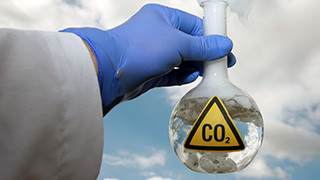 Teams of scientists around the world are pushing forward research on new generations of tin catalysts to battle climate change. Several recently published scientific papers describe new tin prototypes and insights that advance the efficiency and selectivity of tin-based technologies for converting carbon dioxide to useful products.
Teams of scientists around the world are pushing forward research on new generations of tin catalysts to battle climate change. Several recently published scientific papers describe new tin prototypes and insights that advance the efficiency and selectivity of tin-based technologies for converting carbon dioxide to useful products.
The IPCC (Intergovernmental Panel on Climate Change) states that global atmospheric temperatures should not rise more than 1.5⁰C above pre-Industrial levels to avoid rapid polar ice melting. To artificially increase how fast carbon dioxide (CO2) is removed from the atmosphere and mitigate future warming, CO2 can be captured and either stored in geological reservoirs (carbon-capture and storage, CCS) or alternatively used to produce products with economic value (carbon-capture and utilization, CCU).
As CO2 is stable at atmospheric conditions, a lot of energy is required to convert the gas into a useable product so catalysts must be used. Tin-based electrocatalysts are thought to be one of the most promising candidates. The products made using a tin-based catalyst can vary but formate (a precursor to formic acid) is the most common.
A team of scientists from Wuhan University of Technology created a CCU catalyst by coating tin and cobalt in various ratios onto a copper foam. The most efficient catalyst was found to be that with the highest proportion of tin: a 19:1 ratio of tin:cobalt achieved a Faradaic efficiency of 72.7% at -1.36V potential. Faradaic efficiency measures the percentage of CO2 that is successfully converted to the product formate. Formate was produced at a rate of 1.12 µmol h-1.
A second group, working jointly in Nanjing University and Washington State University, created a hierarchical-tin-oxide nanosheet (H-Sn3O4 NS). This material had a 91.1% Faradaic efficiency at -1.02V. The high surface area of this catalytic material was key to achieving this high efficiency.
Thirdly, a team from ShanghaiTech University created a nanorod sheet tin-oxide catalyst. This catalyst was designed to maximise the rate of CO2 to formate conversion by tin. The Faradaic efficiency of this material reached 94% at a potential of -0.7V, the highest CO2 to formate conversion efficiency of any cathode.
Finally, a joint team from across South Korea created a catalyst with tin nanoparticles supported on carbon nanotubes. By changing the metal ion in the liquid surrounding the catalyst (the electrolyte) from lithium to caesium, the scientists doubled the rate of production of carbon monoxide whilst keeping the rate of formate production the same. This result shows the potential for tin-based catalysts to produce a range of chemical products from CO2 via CCU.
Our view: Tin-based catalysts offer an incredibly efficient conversion of the greenhouse gas CO2 to the valuable formic acid. In 2019, the formic acid market was estimated to be 761,123 thousand tonnes by volume, growing 3.8% 2014-2019. Being extensively used in leather production, silage preservation and animal feeds, a tin-based catalyst offers the chance to not only reduce the severity of climate change but also produce a valuable product.
Wuhan University of Technology Paper, Nov 2020
Nanjing University & WSU Paper, Nov 2020
ShanghaiTech University Paper, Dec 2020
South Korea Consortium Paper, Aug 2020
< Back to Carbon Capture
< Back to New Technologies
